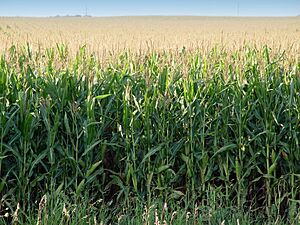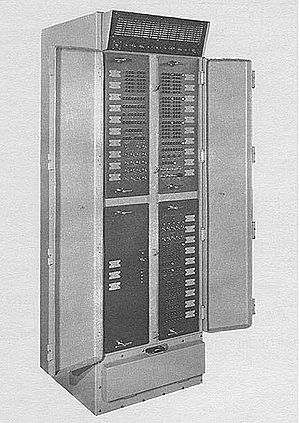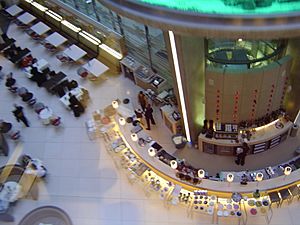Economy of Minnesota facts for kids
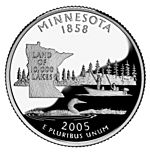
|
|
| Statistics | |
|---|---|
| GDP | $374 billion (2020) |
|
Population below poverty line
|
11.5% (2013) |
| 0.4436 (2011) | |
|
Labor force
|
2,995,400 (December 2014) |
| Unemployment | 3.0% (August 2023) |
| Public finances | |
| Revenues | $20,181.8 million (2013) |
| Expenses | $18,739.5 million (2013) |
The economy of Minnesota is all about how people in the state make and spend money. In 2014, Minnesota produced goods and services worth about $312 billion. Many big companies, like Target and UnitedHealth Group, have their main offices here. In 2016, the average income for each person was about $51,990. This ranked Minnesota sixteenth in the whole country.
Contents
How Minnesota's Economy Grew
Minnesota's economy has changed a lot over the years. It started with simple things like fur trading and farming. Now, it focuses more on making finished products and offering services.
From Farms to Factories
Farming was one of the first big industries in Minnesota. Even today, it's a very important part of the state's economy. However, less than 1% of the people work in farming now.
In an area called the Blufflands, farmers produce special foods. These include cheese, wine, honey, milk, apples, and maple syrup.
Minnesota is a top producer of certain crops for processing. These include sugar beets, sweet corn, and green peas. The state also raises many turkeys for food.
Many companies in Minnesota take farm products and turn them into other foods. Companies like General Mills, Cargill, and Hormel Foods Corporation make things like cereals and packaged meats.
Forests and Mines: Early Industries


Forestry, which is about managing forests and cutting trees, was another early industry. It's still strong today. This includes logging, making paper, and creating other wood products.
Minnesota was once famous for its iron mines. For over 100 years, these mines produced a lot of the world's iron ore. Even though the purest ore is gone, taconite mining is still important. Taconite is a type of iron ore that needs special processing. In 2004, Minnesota produced 75% of the country's usable iron ore.
The city of Duluth became a major shipping port because of mining. Today, it still ships farm products and ore from the Midwest.
Modern Businesses and Shopping
Minnesota is home to many well-known retail companies. These include Target Corporation, Best Buy, and Supervalu. All of these companies have their main offices in the Twin Cities area.
The first fully enclosed shopping mall in the U.S. opened in Minnesota in 1956. It was called Southdale Center. Today, the largest shopping mall in the United States, the Mall of America, is also in Minnesota. It's located in Bloomington.
Minnesota also has a growing medical industry. St. Jude Medical makes medical devices. The world-famous Mayo Clinic is headquartered in Rochester. UnitedHealth Group is one of the largest health insurance companies in the U.S.
Financial companies like U.S. Bancorp and Ameriprise are also based here. Because people in Minnesota love the outdoors, many companies make recreational products. These include snowmobiles and ATVs from Polaris Industries and Arctic Cat.
Today, Minnesota's economy is very diverse. This means it has many different types of businesses. Its business sectors are similar to the rest of the United States.
Minnesota: A Center for Technology
After World War II, Minnesota became a leader in computer manufacturing. Many smart engineers and business people came here. Companies like Engineering Research Associates and Control Data Corporation (CDC) were formed. Seymour Cray, a famous computer designer, started Cray Research here. For many years, Minnesota was a top spot for making advanced computers.
The medical device company Medtronic also started in the Twin Cities in 1949. Even International Business Machines (IBM) had manufacturing and research offices in Minnesota. The state government also helped create a good environment for these tech companies.
In the 1970s, the Minnesota Educational Computing Consortium helped schools get computers. They even created the popular "Oregon Trail" game. Today, Minnesota still has a strong technology sector. It includes companies like 3M, Medtronic, and many smaller software companies.
Big Companies in Minnesota
Many large companies, both non-profit and private, call Minnesota home.
Important Non-Profit Organizations

Here are some of the largest non-profit organizations in Minnesota. These groups receive donations to help people or causes.
| State rank by revenue |
Name | National rank |
Donations ($millions) 2006 estimate |
Headquarters city |
|---|---|---|---|---|
| 1 | Mayo Clinic | 45 | 265.9 | Rochester |
| 2 | University of Minnesota | 46 | 265.4 | Minneapolis |
| 3 | Scholarship America | 114 | 136.2 | St. Peter |
| 4 | Minnesota Public Radio | 378 | 40.3 | St. Paul |
| 5 | Hope for the City | 379 | 40.3 | Edina |
Major Private Companies
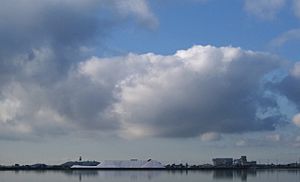
These are some of the largest private companies in Minnesota. Private companies are not traded on the stock market.
| State rank by revenue |
Name | National rank |
Revenue ($billions) 2007 estimate |
Employees | Headquarters city | Known for |
|---|---|---|---|---|---|---|
| 1 | Cargill | 1 | 107.90 | 131,000 | Minnetonka | Farm Products |
| 2 | Carlson | 87 | 38.00 | 170,000 | Minnetonka | Travel and Lodging |
| 3 | Schwan Food Company | 124 | 3.30 | 17,000 | Marshall | Dairy Products and Frozen Foods |
| 4 | Andersen Corporation | 136 | 3.00 | 10,600 | Bayport | Windows and Building Materials |
| 5 | Rosen's Diversified | 184 | 2.40 | 4,200 | Fairmont | Meat Products |
| 6 | M A Mortenson | 218 | 2.14 | 2,700 | Robbinsdale | Heavy Construction |
| 7 | Fagen | 227 | 2.08 | 3,600 | Granite Falls | Heavy Construction |
| 8 | Holiday Cos. | 238 | 2.00 | 4,600 | Bloomington | Retailing |
| 9 | Taylor Corp. | 286 | 1.70 | 12,500 | North Mankato | Publishing – Periodicals |
| 10 | Ceridian | 295 | 1.65 | 9,500 | Bloomington | Information Technology Services |
| 11 | Buffets, Inc. | 334 | 1.46 | 38,000 | Eagan | Restaurants |
| 12 | API Group | 351 | 1.35 | 6,000 | New Brighton | Conglomerates |
| 13 | Lifetouch | 424 | 1.05 | 20,000 | Eden Prairie | Photography |
| 14 | Ryan Companies | 427 | 1.04 | 600 | Minneapolis | Heavy Construction |
Leading Public Companies
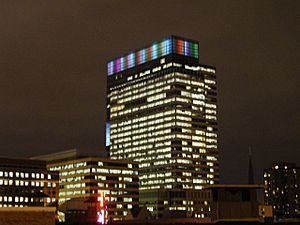
These are some of the largest public companies in Minnesota. Public companies have their shares traded on the stock market.
| State Rank by Revenue |
Company Name | National Rank |
Revenue ($millions) 2010 estimate |
Headquarters City | Known for |
|---|---|---|---|---|---|
| 1 | UnitedHealth Group | 6 | 184,840 | Minnetonka | Managed Health Care |
| 2 | Target | 33 | 67,390 | Minneapolis | Retailing |
| 3 | Best Buy | 47 | 49,694 | Richfield | Retailing |
| 4 | Supervalu | 61 | 40,597 | Eden Prairie | Food Distribution and Retailing |
| 5 | 3M | 97 | 26,692 | Maplewood | Diversified Manufacturing |
| 6 | CHS, Inc. | 103 | 25,268 | Inver Grove Heights | Fuel Distribution |
| 7 | US Bancorp | 126 | 20,518 | Headquarters in Minneapolis, domiciled in Delaware | Banking and Finance |
| 8 | General Mills | 166 | 14,796 | Golden Valley | Food Processing |
| 9 | Land O' Lakes | 218 | 11,146 | Arden Hills | Dairy Products |
| 10 | Xcel Energy | 237 | 10,311 | Minneapolis | Electricity Production and Distribution |
| 11 | Ameriprise | 246 | 10,046 | Minneapolis | Financial Planning |
| 12 | C.H. Robinson Worldwide | 265 | 9,274 | Eden Prairie | Logistic Services |
| 13 | Thrivent Financial for Lutherans | 318 | 7,471 | Minneapolis | Financial Products |
| 14 | Hormel Foods | 325 | 7,221 | Austin | Meat Processing |
| 15 | Mosaic | 346 | 6,759 | Plymouth | Fertilizer Manufacturing |
| 16 | Ecolab | 378 | 6,090 | St. Paul | Sanitation Supplier |
| 17 | St. Jude Medical | 436 | 5,165 | Little Canada | Medical Devices |
| 18 | Nash Finch | 449 | 4,992 | Edina | Food Distribution |
| 19 | Alliant Techsystems | 472 | 4,808 | Eden Prairie | Defense Contractor |
| 20 | Valspar | 618 | 3,482 | Minneapolis | Paint and Coatings |
| 21 | Pentair | 627 | 3,395 | Golden Valley | Water Treatment |
| 22 | Patterson | 687 | 2,999 | Eagan | Dental and Veterinarian Supplies |
| 23 | Securian/Minnesota Life | 729 | 2,746 | St. Paul | Life Insurance |
| 24 | Regis | 730 | 2,739 | Edina | Hair Salons |
| 25 | Fastenal | 813 | 2,340 | Winona | Fastener Manufacturer |
| 26 | Donaldson | 836 | 2,233 | Bloomington | Filtration Products |
| 27 | Imation | 860 | 2,155 | Oakdale | Data Storage Products |
| 28 | Polaris Industries | 911 | 1,948 | Medina | Snowmobiles and ATVs |
| 29 | Toro | 936 | 1,878 | Bloomington | Lawn and Irrigation Equipment |
| 30 | Michael Foods | 961 | 1,804 | Minnetonka | Packaged Foods |
Energy in Minnesota
Minnesota does not produce its own oil. However, it has the largest oil refinery in any non-oil-producing state. This is the Pine Bend Refinery.
Minnesotans use a lot of gasoline every day. About 70% of the gasoline used in the state comes from Pine Bend and the nearby St. Paul Park Refinery.
Renewable Energy and Fuel

Minnesota produces Ethanol fuel. All gasoline sold in the state must contain 10% ethanol (E10). Minnesota is the only U.S. state with this rule.
The state also has the most fuel stations that offer E85 fuel. This type of fuel has 85% ethanol. Since 2005, diesel fuel in Minnesota must also contain 2% biodiesel.
Wind turbines are popular for making electricity, especially in the windy southwest. Minnesota is one of the top states for producing wind power.
Because winters are cold, Minnesota relies a lot on natural gas for heating homes. More than two-thirds of homes use natural gas.
Taxes in Minnesota
Minnesota has a progressive income tax. This means people with higher incomes pay a higher percentage in taxes. There are different tax rates, from 5.35% to 9.85%.
The sales tax in Minnesota is 6.875% for most items. However, you don't pay sales tax on clothing, some services, or food you buy to eat at home. Cities can also add their own local sales taxes.
People who own real property (like land and buildings) in Minnesota pay property tax. This money goes to their county, city, school district, and other special districts.


